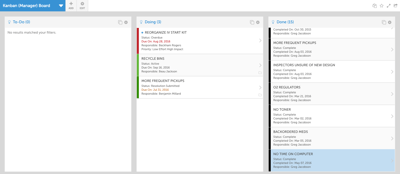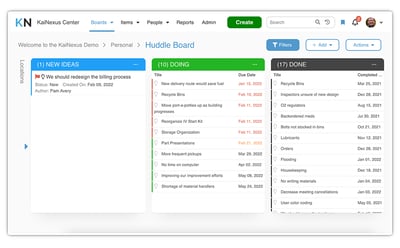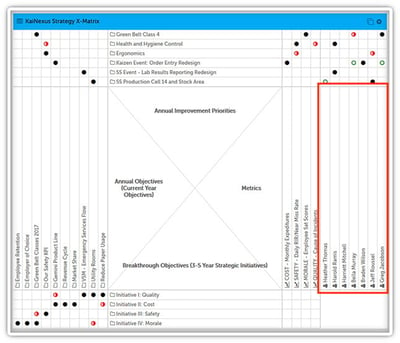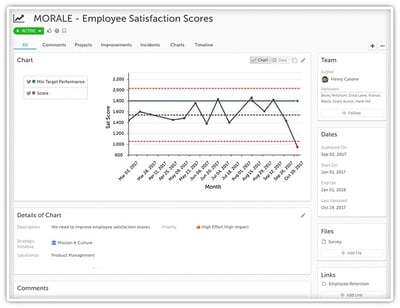Although the overarching objective of Lean management is to create an unhindered flow of value to the customer, another of its primary concerns is transparency. If you can see roadblocks, process irregularities, resources that aren’t at capacity, and poorly aligned goals you can do something about them. That’s why so many Lean tools are designed to allow visual management. People process images much more quickly than text (knowing what’s going on around you is somewhat central to staying alive), that’s why icons, signs that use color and shape, and dashboards are so popular.
Over the years, many valuable tools for Lean visual management have evolved. They offer significant benefits for leaders and team members alike. Here are a few that we’re sure your team will appreciate.
Kanban Boards
 Kanban is a visual system for monitoring the flow of work from the start, as teams build a backlog, move work into in-process (while hopefully limiting WIP), and complete the job. The term Kanban translates from Japanese to mean “signboard” or “visual signal."
Kanban is a visual system for monitoring the flow of work from the start, as teams build a backlog, move work into in-process (while hopefully limiting WIP), and complete the job. The term Kanban translates from Japanese to mean “signboard” or “visual signal."
Kanban was developed by Toyota in the 1940s to create the ability to produce work just-in-time, limit inventory, and optimize the flow of parts and labor. Kanban cards were used to signal when inventory needed to be replenished on the factory floor and when more parts needed to be ordered. Kanban cards are still used in manufacturing and other industries, but the idea has also been adapted for other industries. Kanban boards, which show any work in progress are now quite widespread. The work may be a software release moving from requirements definition, to development, through QA, to production. No matter the nature of the work-in-progress, cards or software can be used to track work and manage flow.
Digital Huddle Boards
 Teams dedicated to continuous improvement often hold a daily huddle meeting to chat about the progress of improvement projects and track key performance indicators.
Teams dedicated to continuous improvement often hold a daily huddle meeting to chat about the progress of improvement projects and track key performance indicators.
Huddle boards are used to collect and communicate this information. In the past, they were often nothing more than a whiteboard or poster on the wall, but today organizations use a digital model to ensure that distributed teams can work together and that leaders have easy access to the board of every team. The best solutions allow teams to configure huddle boards to include the most essential information for them. They may consist of any data that the team needs to track. Some organizations use rolled up location huddle boards and personal huddle boards as well.
X-matrix
 The X-matrix is a way to visualize strategy deployment. The X matrix includes four quadrants (made up by the cross in the X) and one additional section. The layout of the model helps define the relationships between each of them.
The X-matrix is a way to visualize strategy deployment. The X matrix includes four quadrants (made up by the cross in the X) and one additional section. The layout of the model helps define the relationships between each of them.
The bottom quadrant contains the breakthrough objective. These are the key strategic goals that are to be achieved within the next three to five years. The left quadrant houses the annual objectives which are the shorter-term goals that are necessary to reach the breakthrough objectives. At the top are the annual improvement opportunities and priorities. These opportunities are aligned with a yearly objective. The right quadrant contains the metrics to measure and targets to improve, in other words, the definition of success. Teams and ownership are assigned on the far right of the matrix. Icons are used at the interactions of items to indicate how they are related.
The X-matrix is a great way to communicate the strategy and ensure that priorities are kept in line.
Control Charts
 A process control chart is a graph used to monitor how a process behaves over time. Data are plotted in time order. A control chart always has a central line for the average (sometimes a median), an upper line for the upper control limit, and a lower line for the lower control limit. These lines are calculated from historical data and usually cover three standard deviations from the mean.
A process control chart is a graph used to monitor how a process behaves over time. Data are plotted in time order. A control chart always has a central line for the average (sometimes a median), an upper line for the upper control limit, and a lower line for the lower control limit. These lines are calculated from historical data and usually cover three standard deviations from the mean.
Control charts help managers avoid overreacting to common cause variations that are normal within a process. They also make it clear when a special cause variation, a more concerning event, occurs. They also help identify trends that may mean the process is heading toward a new “normal” that may or may not be OK.
As you can see, Lean visual management tools cover the gamut from strategy deployment to quality control and process management. When they are deployed as part of an overall Lean management software platform, they become powerful tools that help organizations achieve even the loftiest of goals.




Add a Comment